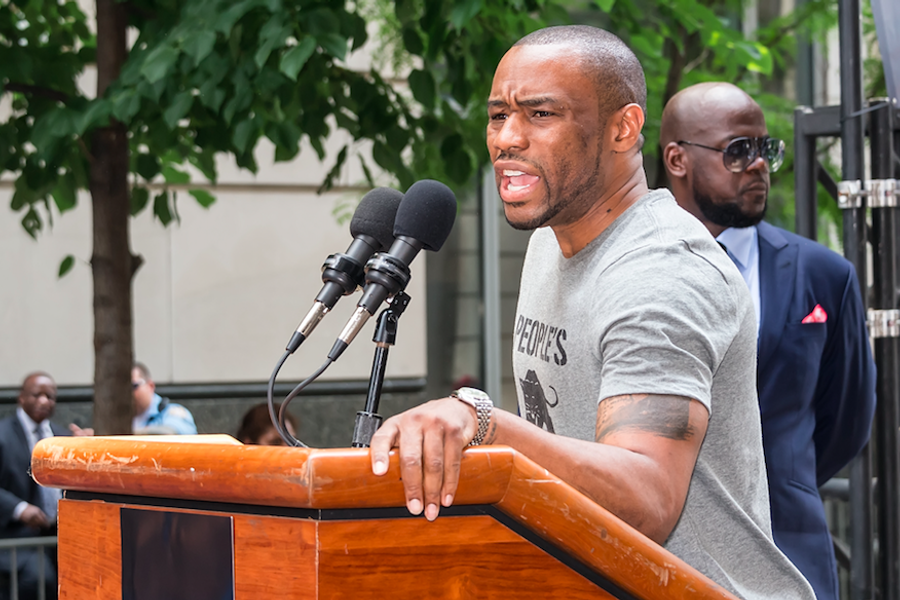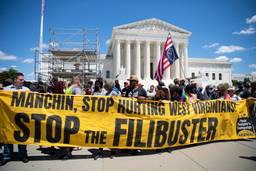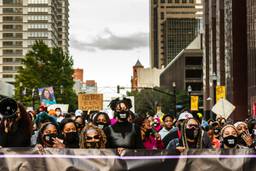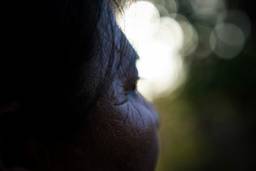
When Temple University Professor Marc Lamont Hill hit the United Nations in late November to uplift the struggle for Palestinian human rights, he did so with an urgency Black radicals have brought for decades.
Addressing the global body on the International Day of Solidarity with the Palestinian People, Hill rebuked the Israeli government’s brutal treatment of Palestinians, who live under an internationally recognized illegal occupation that fits the legal definition of apartheid.
Up to that point, Hill had worked as a CNN commentator and analyst, where he often exposed United States’ violent history of racism, sexism and imperial aggression. But it was his UN performance, and specifically his call for “a free Palestinian from the river to sea,” that finally got him banished from the network. In making that radical demand — that Palestinians ought to live free from discrimination in a state where everyone has equal rights to participate in the nation’s political, economic and cultural life — Hill recognized similarities between that struggle and the one waged by Black Americans. He asserted that, as a Black American, he was well acquainted with how one can be called to resist oppression in the way the Palestinian people had. In his own words:
As a Black American, my understanding of action, and solidarity action, is rooted in our own tradition of struggle. As Black Americans resisted slavery as well as Jim Crow laws that transformed us from a slave state to an apartheid state we did so through multiple tactics and strategies.”
… Contrary to western mythology, black resistance to American apartheid did not come purely through Gandhian nonviolence. Rather, slave revolts and self-defense and tactics otherwise diverging from Dr. Kind of Mahatma Gandhi were equally important to preserving safety and attaining freedom. … If we are standing in solidarity with the Palestinian people, we must recognize the right of an occupied people to defend itself.
We must prioritize peace, but we must not romanticize or fetishize it. We must advocate and promote nonviolence at every opportunity, but we cannot endorse a narrow politics of respectability that shames Palestinians for resisting, for refusing to do nothing in the face of state violence and ethnic cleansing.
… We have an opportunity to not just offer solidarity in words, but to commit to political action, grassroots action, local action, and international action that will give us what justice requires — and that is a free Palestine from the river to the sea.
What came next was a firestorm of charges that his words were those of a raving anti-semite hell-bent on Israel’s annihilation. Hill did a fine job defending himself in a string of tweets. He also penned a thoughtful reflection on the episode at the Philadelphia Inquirer. In it, Hill fills in some forgotten, if not willfully ignored, details about the history and language of Palestinian liberation. He manages to reflect soberly on the heat that language can generate while refusing to apologize for — or retreat from — his unflinching support of Palestinian rights. It is a difficult tight rope to walk and he does it with remarkable grace.
Against imperial power
As Hill would be the first to note, his remarks were grounded in a tradition that stretches back generations. Over the years, radical Black activists and cultural figures have routinely linked up with their Palestinian counterparts as they travel their own distinct — but similar — paths. As Professor Robin D.G. Kelley of the University of California - Los Angeles notes, there was nothing inevitable about this alliance. “Solidarity takes struggle,” he tells In These Times. In other words, forging something durable and meaningful was only made possible through tireless work across years of struggle filled with hard lessons and shattering losses.
Take Israel’s 1948 founding. “Black leaders and the Black press, for the most part, were jubilant,” Kelley writes in his book Apartheid Israel: the Politics of an Analogy. He highlights the words of the NAACP, a powerful organ of the Black political establishment at the time, which argued that “the valiant struggle of the people of Israel for independence serves as an inspiration to all persecuted people throughout the world.” That attitude was shared by radical voices of the era from A. Philip Randolph to W.E.B. DuBois, and a Black press that “overwhelmingly portrayed Arabs as the brutal, bloodthirsty aggressors,” writes Kelley.
“They identified with the founding of Israel, because they recognized European Jewry as an oppressed and homeless people determined to build a nation,” Kelley writes. In other words, early Black enthusiasm for Israel’s establishment grew out of a desire to see an oppressed Jewish people, devastated by the lethal efficiency of the Holocaust, set free from the power another group had over their lives.
But the young nation of Israel itself sat atop a mountain of devastation — roughly 750,000 Palestinians had been ethnically cleansed from the land in a brutal episode known as the Nakba, or “Day of Catastrophe.” And that nation was launched through a process of settler colonialism, with Israel — backed by imperial powers — emerging as a brutal colonial power.
That uncritical support of Black figures would soon transform into something else entirely. Between the 1956 invasion of Egypt by Britain, France and Israel, and the 1967 war that kicked off Israel’s illegal occupation, whatever fog was blinding the more radical corners of the Civil Rights movement began to clear. From Malcolm X to the Student Nonviolent Coordinating Committee (SNCC) to the Black Panther Party, many Black freedom fighters were jolted by what these incidents revealed: The Palestinian people had been sacrificed to Israel’s colonial project.
At the time, resistance to imperial power was in full bloom. Following World War II, countless Third World nations were throwing off the shackles of their colonial masters. It’s no surprise that Black radicals the world over came to view the Palestinians as engaged in a struggle like their own, against a colonial power that was grinding them underfoot. As Kelley observes in Apartheid Israel, “Malcolm concluded that Zionism represented a ‘new form of colonialism,’ disguised behind biblical claims and philanthropic rhetoric, but still based on the subjugation and dispossession of indigenous people and backed by U.S. ‘dollarism.’”
A new generation
Today, a new generation of activists has picked up where previous ones left off. The year 2014 saw what Kelley calls “another Freedom Summer,” a callback to the bloody months of 1964 when SNCC members battled Mississippi apartheid. Fifty years later, in the wake of the police murder of unarmed Black teenager Michael Brown in Ferguson, Missouri, Black youth were sculpting their enormous grief into a movement against the long and ongoing history of violence against Black communities, and its origins in American policy. At the same time, and over 6,000 miles away, the people of Gaza, 50 percent of whom are children, were being blown away by the thousands at the hands of Israel’s U.S.-funded war machine. What followed was a burst of solidarity shooting across each side of the Atlantic.
Kristian Davis Bailey offers in an insightful primer on this chapter for the academic journal American Quarterly. “The Ferguson-Gaza moment,” Bailey writes, “marked an increase in mainstream U.S. political awareness and momentum shift for both Black and Palestinian Liberation struggles.” Over the months and years since, the movements have cross-pollinated.
In 2015, a vast array of prominent Black scholars, thinkers and organizations, including Angela Davis and Cornel West and Florida’s Dream Defenders, signed a statement declaring their “commitment to working through cultural, economic, and political means to ensure Palestinian liberation at the same time as we work towards our own.” And in that same year, Professor Hill himself traveled with members of Dream Defenders and Black Lives Matter, among others, to Palestine and Israel where they held a demonstration against “the occupation, ethnic cleansing and brutality Israel has levied against Palestinians.”
There are significant and unmistakable differences between the two peoples’ experiences. For example, take the way each is viewed by those who control their lives. The species of apartheid that defined South Africa and the Jim Crow Southern United States relied on Black populations as a cheap, and often unpaid, workforce. Meanwhile, the Palestinians of Gaza, who Israeli leaders have placed “on a diet,” are almost an entirely unwanted, surplus population. This conclusion has been echoed by some of those who fought to vanquish South African apartheid. Traveling with a group of South African activists visiting Israel in 2008, Israeli journalist Gideon Levy writes of them describing conditions in Gaza and the West Bank as “worse than anything they knew under apartheid.”
But for activists, the resemblances have been too many and too striking to ignore. Each saw in the other glimpses of their own harrowing journey: a poor, Black and Brown people locked away in ghettos trying desperately to break free. Palestinians watched as Black outrage in Ferguson was met by a police force (and police chief who was one thousands of American officers who’ve received training in Israel) armed to the teeth with military-grade weaponry. Many Palestinians immediately recognized the impossible odds their counterparts faced as familiar: They had also faced a vastly superior force. And the press had also written about them as if their rocks and bodies were evenly matched with the world’s most sophisticated military weaponry. And when those people were being tear gassed in the streets of Ferguson, with the exact same brand of tear gas that Palestinians are so often bombarded with, Palestinians offered strategies on how to weather the ordeal.
For radical Black Americans, who hail from communities that are policed and imprisoned under a system that renders poor Black life criminal, it’s easy to identify with a people living, as Gazans do, in an “open-air prison.”
“Mass action across the country,” Bailey writes, occurred “just as U.S. outcry against Israel’s 50-day war on the Gaza Strip reached its fever pitch. Protesters from Oakland to New York chanted ‘from Ferguson to Palestine, occupation is a crime’ and began to highlight connections between the two struggles.”
It is in the spirit of this tradition that Hill made his remarks. It is not the only tradition of Black engagement with the Palestinian cause. As Professor Kelley has observed, there is an equally long chain of powerful and prominent Black figures who have looked away from both American and Israeli crimes when convenient. The 2014 war in Gaza, after all, took place under the watchful eye, and with the decisive backing, of America’s first Black president. Obama would end his presidency by signing off on the largest military aid package to Israel in U.S. history. But no one on the radical side of that tradition has pinned their hopes to the good will of people with power. Rather, they’ve thrown in with those the powerful have trampled. It is around this basic shared aspiration, of oppressed people struggling to set themselves free, that activists from the ghettos of Palestine to the United States have met and locked arms.
ELI DAY was an investigative fellow with In These Times’ Leonard C. Goodman Institute for Investigative Reporting. He’s also a Detroiter, where he writes about politics, policy, racial and economic justice. His work has appeared in Vox, Current Affairs, Mother Jones, and the New Republic, among others.







